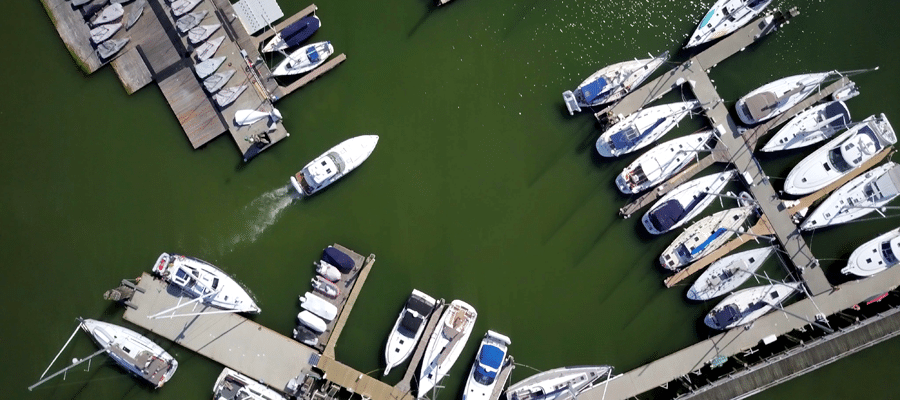My first serious job in the recreational marine industry was managing a small 40-slip marina and trailer park on the Lake Erie shore. That was at a time before anyone ever heard of a desktop computer.
A decade later, I found myself with upper-level management responsibility for a 100-slip marina and full-service boatyard on the Florida West Coast, where part of my brief was to condominiumize the marina while at the same time putting the boatyard back on its feet financially.
Fast-forward another decade and a half and you find me running a major yacht-building operation, with executive responsibilities not only for two shipyards, but for two substantially-sized marinas as well, one on Lake Michigan and one on the Southeast Atlantic coast.
I mention this not to impress you, but to indicate that, if you’re a marina owner or manager, I understand many of your problems and have experienced most of your struggles. Moreover, I mention it to signal I am not simply a writer pulling bull-chips of advice out of my … ear.
How to Drive Marina Customers Away
The one statement I can make confidently and without qualification is that the quickest way to chase away marina business is to adopt some of the in-vogue computerized automated customer interfaces (CX) available today.
That’s because the primary deliverable in the marina business is service. And there is nothing as destructive of the relationship between a service customer and a service vendor as a barrier to direct contact between them.
Oh sure, customers have gotten used to dealing with automated telephone answering systems which force them through a series of menus to leave a message and be called back. But that is not the same as coming up against a robotic “sales assistant” masquerading as a responsive humanoid.
There are some functions which appear to be natural candidates for being automated via computerization, for example, making airline or hotel reservations, or even shopping for a new automobile — especially when the customer is experienced, already knows in general terms what he or she wants, and is just looking to make a final decision and place the order. In such cases, many customers, myself included, are in fact relieved to be left to their own devices to act at their leisure.
I’ve Never Met a Chat-Bot I Didn’t Hate
In those circumstances, I personally prefer to deal with a computerized system — assuming it works properly and smoothly — to dealing with a live person. For unlike human sales assistants, automated systems are infinitely patient while I work through all the what-if scenarios I can concoct in an effort either to get as precise a match as possible to my needs and requirements or to secure the best available price or to simply assure myself that I am not missing any viable options.
Granted, my perspective cannot be generalized. It is, nevertheless, mirrored by the growing popularity of online shopping — which is, more and more, embracing automation. However, it’s worthwhile repeating that automation in service delivery is bound to fail if pursued as a replacement for all live contact.
The Automated Dock Master (Not to be Confused with DockMaster®)
In a marina context, the primary reason to automate is to streamline the delivery of services and in doing so, improve the customer experience. However, it’s also important to differentiate between automations used to support the delivery of services from those seeking to economize, for example, on payroll costs by employing “chat-bots” posing as real persons — and invariably doing a poor job of it.
It makes good operational and business sense to automate those marina processes which are naturally amenable to being comfortably self-scheduled or self-selected by customers. Things like transient slip rentals and reservations; boat haul-outs, cleanings, and provisioning. Or rental boat selection and reservations.
Well-chosen and executed automations can draw marina customers into feeling at least partial ownership in how their boats and yachts are cared for. That makes for increased customer loyalty and more relaxed pricing resistance. Which, in turn, opens the road to improved profits.
In my experience, automation solely for automation’s sake is never a winner. What you want to avoid are inappropriately chosen and poorly implemented automations that ultimately frustrate and annoy customers. For instance, a chat-bot that can discuss a double-shot latte but cannot answer a simple question about the depth of the water at your marina at mean low tide.
Most of the time, the best solution to the need for customer interaction in a marina context is a human interface. That’s because service customers do not pay you only for what you deliver to them in goods and services but also for what you know — and for the fact you make them feel that they and their boat or yacht matter to you.
— Phil Friedman, Marine Industry Consultant
Copyright © 2018 by Phil Friedman and DockMaster — All Rights Reserved
–
DockMaster Software is an industry leading management system for marinas, boatyards, and boat dealerships. DockMaster includes Unit Sales, Prospecting and F&I with fully integrated financial management and numerous integrations with CRM applications, dealer websites and text/messaging services. The Service module includes estimating, labor tracking, and complete parts management with ordering/receiving, subcontractor fulfillment and invoicing. DockMaster Mobile allows technicians to clock on/off jobs from any mobile device. Visual Marina™ management includes storage & billing, occupancy tracking, reservations and dry stack management, including integrations to leading consumer applications for boat rentals, online reservations, concierge/launch scheduling and our new Fuel Integration with FuelCloud. DockMaster also includes Point of Sale, Order Entry with eCommerce and a complete accounting system. Learn more at www.DockMaster.com and follow DockMaster on Twitter, Instagram, Facebook, and LinkedIn. Or email info@dockmaster.com

